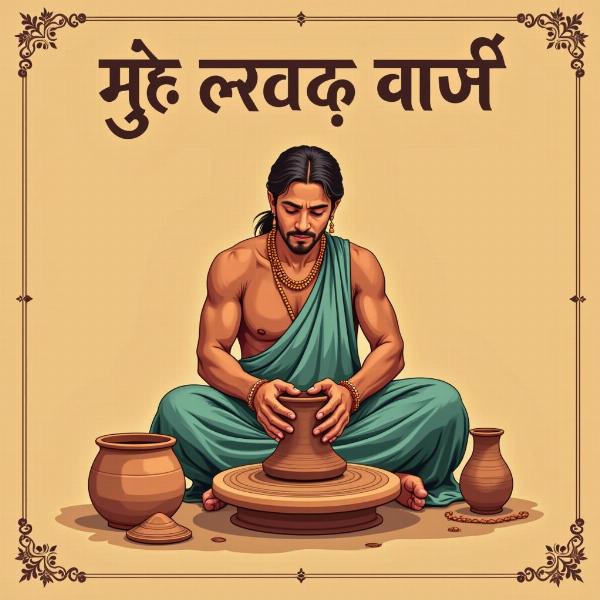Understanding the meaning of “formed” in Hindi is crucial for accurate translation and communication. Whether you’re translating business documents, legal texts, or everyday conversations, grasping the nuances of this word can significantly impact the clarity and effectiveness of your message. “Formed” in English can encompass various meanings, from creation and establishment to shaping and development. This article will explore the different Hindi equivalents of “formed” and provide practical examples to help you choose the most appropriate translation in various contexts.
Different Hindi Translations of “Formed”
The Hindi language offers several translations for “formed,” each with its own subtle differences in meaning and usage. Choosing the right word depends heavily on the specific context. Here are some common Hindi translations of “formed”:
- बना (banā): This is the most common and versatile translation of “formed.” It signifies creation, making, or building something. For instance, “The committee was formed last week” can be translated as “समिति पिछले हफ्ते बनी (samiti pichle hafte banī).”
- गठित (gathit): This term is often used in formal contexts, particularly when referring to the formation of organizations, committees, or groups. It implies a more structured and official process of formation. For example, “A new government was formed” can be translated as “एक नई सरकार गठित हुई (ek naī sarkār gathit huī).”
- रचित (rachit): This word is typically used for creative works, such as composing music or writing literature. It implies artistic creation or composition. “The song was formed beautifully” can be translated as “गीत सुंदर रूप से रचित था (gīt sundar rūp se rachit thā).”
- निर्मित (nirmit): This word suggests construction or manufacturing, often implying a physical process of creation. For example, “The statue was formed from bronze” translates to “मूर्ति कांस्य से निर्मित थी (mūrti kānsya se nirmit thī).”
- आकार दिया गया (ākār diyā gayā): This phrase emphasizes the act of giving shape or form to something. It’s suitable when talking about molding, sculpting, or designing. “The clay was formed into a pot” can be translated as “मिट्टी को एक बर्तन का आकार दिया गया (miṭṭī ko ek bartan kā ākār diyā gayā).”
 Meaning of Formed in Hindi
Meaning of Formed in Hindi
How to Choose the Right Hindi Translation
Selecting the appropriate Hindi translation for “formed” requires considering the specific context and the nuance you want to convey. Here’s a quick guide:
- For general creation or formation: Use बना (banā).
- For formal establishments or organizations: Use गठित (gathit).
- For creative works: Use रचित (rachit).
- For physical construction or manufacturing: Use निर्मित (nirmit).
- For shaping or molding: Use आकार दिया गया (ākār diyā gayā).
Common Mistakes to Avoid
When translating “formed” to Hindi, avoid directly substituting the English word with the first Hindi equivalent you find. Consider the context carefully to ensure accuracy and avoid misinterpretations.
Practical Examples of “Formed” in Hindi
Let’s look at some practical examples to illustrate the usage of different Hindi translations of “formed”:
- The company was formed in 2010: कंपनी 2010 में स्थापित हुई (kampanī 2010 meṃ sthāpit huī) (Using स्थापित (sthāpit) which is another suitable word for establishing a company)
- The clouds formed into interesting shapes: बादल दिलचस्प आकार में बदल गए (bādal dilchasp ākār meṃ badal ga.e) (Using बदल गए (badal ga.e) meaning transformed into)
- A new political party was formed: एक नया राजनीतिक दल गठित हुआ (ek nayā rājanītik dal gathit huā)
- The sculpture was formed from marble: मूर्ति संगमरमर से निर्मित थी (mūrti saṅgamarmar se nirmit thī)
Conclusion
Understanding the various Hindi translations of “formed” is essential for effective communication. By carefully considering the context and choosing the most appropriate equivalent, you can ensure accuracy and clarity in your translations. This nuanced approach to translation will enhance your understanding of the Hindi language and facilitate better cross-cultural communication.
FAQ
-
What is the most common Hindi word for “formed”?
The most common Hindi word for “formed” is बना (banā). -
When should I use गठित (gathit) instead of बना (banā)?
Use गठित (gathit) when referring to the formation of organizations, committees, or groups, especially in formal contexts. -
Which word should I use for creative formations?
Use रचित (rachit) for creative formations like composing music or writing literature. -
What about physical constructions?
For physical constructions or manufacturing, use निर्मित (nirmit). -
How do I translate “formed into a shape”?
Use आकार दिया गया (ākār diyā gayā) or a phrase like बदल गया (badal gayā) when referring to something transforming into a shape.
Meaning-Hindi.in offers professional translation services specializing in Hindi and other languages. We handle various translation needs, including business and commercial documents, legal and certified translations, technical manuals, website localization, and educational materials. Our expertise ensures accurate and culturally sensitive translations. Contact us at [email protected] or +91 11-4502-7584 for a quote or to discuss your project. Meaning-Hindi.in is your trusted partner for high-quality Hindi translations.